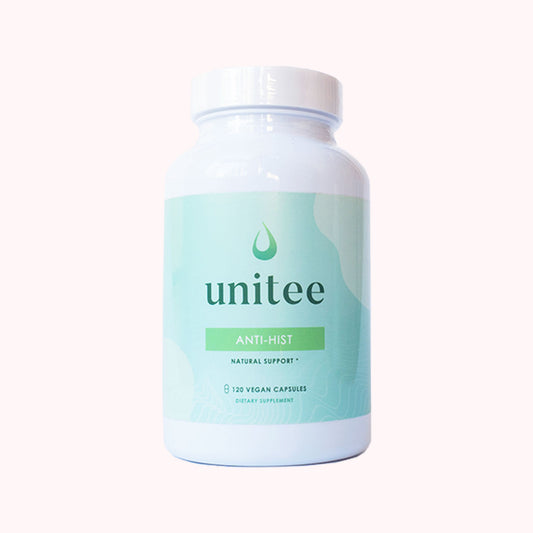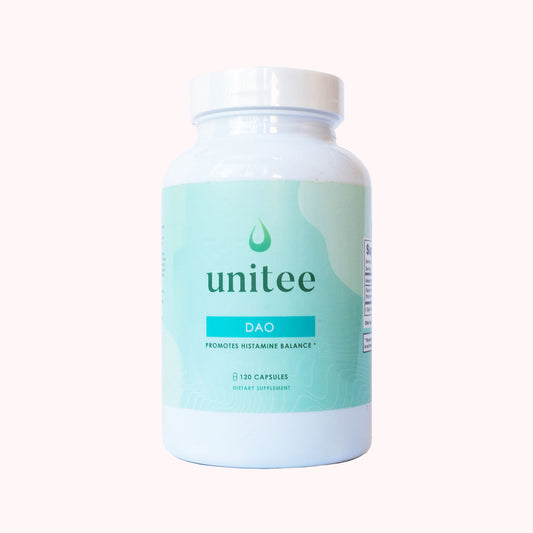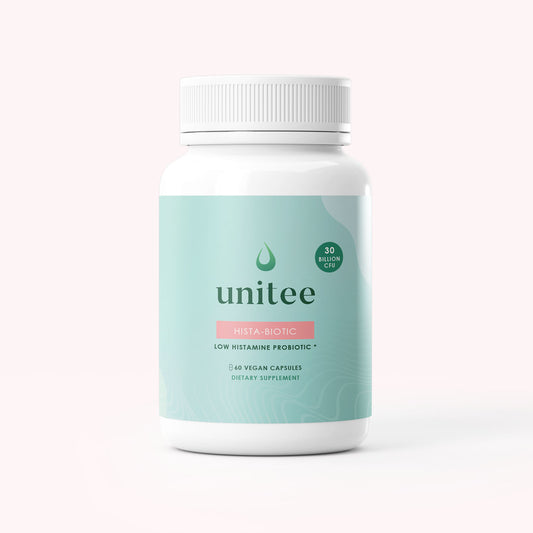One of my favorite things when it’s hot outside is to have something icy cold.
And what could be better than ice cream!?
Now, you all know I struggled with the debilitating effects of histamine intolerance and, as a result, I wasn’t able to do many of my favorite things, never mind even think about eating ice cream.
Then, as I started to heal, I began wanting to get back to some of my old enjoyable habits. Of course, I couldn’t quite enjoy the types of ice cream I used to for fear of it bringing back many bothersome symptoms. So I started thinking more creatively about how I could still get the same joyful feeling I used to while eating ice cream, but without suffering. Besides, I fully believe finding joy in life - and especially food - when you’ve been through such a dramatic life-altering illness is key to reducing stress and further supporting your healing journey.
With all that being said, I started experimenting with simple, low histamine ingredients that would allow me to eat ice cream again. Now I’m sharing this delicious 2-ingredient low histamine ice cream recipe with you, so you too can enjoy it when it’s hot outside - or on any other day of the year when you’re craving a little treat.
Does Low Histamine Ice Cream Fit Into a Healthy Diet?
Of course, the end goal for adding low histamine ice cream to your diet is to feel happy about what you’re eating while satisfying a craving. Beyond that, it’s important for the ingredients to nourish your body, especially since you’re likely still following a more restrictive diet.
That’s why, as the first ingredient, I chose to use coconut cream in this recipe as the base instead of dairy. While dairy is not typically histamine-containing, and I know many people who can tolerate a small amount of dairy while following a low histamine diet, it can be quite bothersome in larger amounts, and it can be inflammatory for others.
Coconut cream is naturally low in histamine and generally well tolerated, and it has some pretty potent health benefits for those living with histamine intolerance. It’s rich in medium-chain triglycerides (MCTs), which can add a healthy fat to your diet, and bring up your daily calorie intake in a beneficial way. One of coconut cream’s MCTs we’re also interested in when it comes to histamine intolerance is lauric acid, which has antimicrobial and anti-inflammatory properties that may support gut health — a key area of focus for managing your condition (1). A healthier gut barrier and more balanced microbiota can help reduce histamine load and improve function of the all important diamine oxidase (DAO) enzyme responsible for breaking down histamine (2).
Coconut cream is also free from casein and lactose, two common inflammatory triggers in sensitive individuals. Its creamy texture and mild flavor make it ideal for replacing dairy, offering a similar mouth feel to eating ice cream, without the consequences. Additionally, the healthy fats in coconut cream support hormone balance and blood sugar regulation, both of which can indirectly help stabilize histamine-related symptoms.
The second ingredient is monk fruit powder. Unlike commercial sugar, monk fruit powder is a natural, low-histamine sweetener derived from a vine fruit. It provides the sweetness of sugar without having a spiking effect on your blood sugar. Additionally, it contains anti-inflammatory and antioxidant properties (3).
Be sure to get organic, 100% monk fruit powder as there are commercially available blends containing erythritol, which can cause digestive upset in sensitive individuals!
And those two ingredients are all you need as the base of a good ice cream. You’re welcome to add a pinch of salt to bring out more flavor in the ice cream (salt stimulates the tastebuds, and may help with low blood pressure!), or add a little vanilla paste, if you’d like.
Otherwise, we can add some other yummy, healthy ingredients to jazz up the treat.
Individualizing Your Low Histamine Ice Cream With Delicious and Nutritious Ingredients
When you're building a low histamine recipe, you want to layer in ingredients that not only avoid triggering symptoms but also offer health benefits. And here’s where you can get creative when it comes to your low histamine ice cream…
Blueberries
Getting a so-called superfood into your ice cream is a fantastic way to give a health boost to an enjoyable treat.
Blueberries have been listed as one of the most nutritious foods on earth, and for good reason. The pigments giving blueberries their deep color, called anthocyanins, have been shown to improve the way your tissues function, help to reduce inflammation, and can enhance memory and cognitive function (4). These little anthocyanidin antioxidant compounds are able to act on every tissue in your body to protect them from damage - just what you need when you’re living with histamine intolerance. Blueberries are also a great source of dietary fiber, which can help to prevent unwanted blood sugar spikes.
Macadamia Nuts
Nuts are usually a no-no when it comes to a low histamine diet! Fortunately, we have macadamia nuts! They are one of the lowest-histamine, most nutrient-dense nuts out there. They’ve been found to be much gentler on sensitive systems and will add a lovely buttery flavor to ice cream.
Macadamia nuts also offer health benefits because they’re rich in thiamine, manganese, and healthy fats (5), making them an excellent addition to your dairy-free dessert.
They’re versatile, too. You can keep them chunky, chop them finely, or make a macadamia nut butter (my recipe!) and swirl it into your low histamine ice cream base - my personal favourite!
Mint
Mint is a powerhouse when it comes to digestive support. It helps with bloating and gas, and can calm tummy troubles. While some varieties (like peppermint) can be stimulating in high doses, a small amount of spearmint or fresh garden mint is generally well-tolerated and adds a cooling, uplifting flavor.
Mint contains a special oil called rosmarinic acid, which has been shown to have anti-inflammatory and antiallergenic effects. Studies have found rosmarinic acid significantly reduced nasal congestion and itching in individuals with seasonal allergic rhinitis (6,7), which can be translated into having potential benefits for reducing histamine-related symptoms.
Cucumber
Cucumber ice cream?! I know, I know. I was a skeptic too, but don’t knock it until you try it. It’s honestly such a mildly pleasant, refreshing and hydrating flavor, and is especially delightful when it’s hot outside.
While cucumber can seem quite bland, it has some benefits! Not only is it low in histamine, it’s rich in silica, a trace mineral that supports skin elasticity and connective tissue health. It also provides potassium, vitamin K, and antioxidant compounds (8).
Now for what you’ve all been waiting for: the recipe!
Here’s Your Easy 2-Ingredient Low Histamine Ice Cream Recipe
Base Ingredients:
- 1 can (400 mL) full-fat coconut milk (no additives, BPA-free if possible)
- ⅛ tsp 100% monk fruit powder (or adjust to taste)
Optional base ingredients:
- 1 tsp pure vanilla paste or powder (not extract, which can be high in alcohol and histamine)
- Pinch of salt (Himalayan or Celtic salt preferred due to higher variety of minerals compared to table salt)
Optional yummy additions:
- ½ cup fresh or frozen blueberries
- ⅛ tsp 100% monk fruit powder (or adjust to taste)
- ¼ cup raw macadamia nuts (soaked in water for 4 hours or overnight, then drained, chopped or creamed into a butter)
- 1 small cucumber, peeled and deseeded
- 1–2 tbsp fresh mint leaves (adjust to your taste)
Instructions:
Blend the base: In a high-speed blender, combine coconut milk, monk fruit, and vanilla powder and a pinch of salt, if using. Blend until completely smooth and creamy. The mixture should look quite fluffy.
Freeze: Pour the mixture into a freezer-safe container. Cover and freeze for 4–6 hours, stirring once or twice in the first two hours to reduce iciness. If you have an ice cream maker, churn for 20–25 minutes before freezing. I highly recommend an ice cream maker as it give a wonderful creaminess to the finished product.
Serve: Once frozen, let your ice cream thaw for 5–10 minutes before scooping.
If you’re adding any extras, get creative and add as many as you like. Simply pop them into the blender once you reach the desired creamy consistency of the base ingredients. Pulse each ingredient in for a few seconds if you like some texture, or blend them in completely if you prefer a smooth consistency.
Why This Low Histamine Ice Cream Recipe Works for Sensitive Individuals
This recipe avoids common histamine triggers and instead focuses on:
- Whole foods to nourish your body
- Anti-inflammatory ingredients to support healing
- Nutrients to improve the health of the gut, brain, and immune system
- Enjoyment of food while on a limited diet
When you’re dealing with histamine intolerance, every meal can feel like a gamble, which can lead to food fear and stress. But gradually expanding your diet with safe, joyful recipes like this one is one way to regain confidence and reconnect with pleasure in eating.
Nourishing treats like this don’t just satisfy a craving, they support your healing process on multiple levels.
So next time you’re longing for something sweet, creamy, and cold, give this low histamine ice cream a try. I hope you discover a new favorite that makes your body and your spirit feel joy.
References:
1. Zhang Y, Ma H, Yuan T, Seeram NP. Red Maple (Acer rubrum) Aerial Parts as a Source of Bioactive Phenolics. Nat Prod Commun. 2015;10(8):1409-1412.
2. van Odijk J, Weisheit A, Arvidsson M, Miron N, Nwaru B, Ekerljung L. The Use of DAO as a Marker for Histamine Intolerance: Measurements and Determinants in a Large Random Population-Based Survey. Nutrients. 2023;15(13):2887.
3. Yeung AWK. Bibliometric analysis on the literature of monk fruit extract and mogrosides as sweeteners. Front Nutr. 2023;10:1253255.
4. Basu, A., et al. (2010). Blueberries decrease cardiovascular risk factors in obese men and women with metabolic syndrome. Journal of Nutrition, 140(9), 1582–1587.
5. Tu XH, Wu BF, Xie Y, et al. A comprehensive study of raw and roasted macadamia nuts: Lipid profile, physicochemical, nutritional, and sensory properties. Food Sci Nutr. 2021;9(3):1688-1697.
6. Friedman, T. (2015). The Effect of Rosmarinic Acid on Immunological and Neurological Systems: A Basic Science and Clinical Review. Journal of Restorative Medicine, 4(1), 50–59.
7. Osakabe, N., et al. (2004). Rosmarinic acid inhibits the allergic inflammatory response through inhibition of histamine release and pro-inflammatory cytokine expression. Clinical & Experimental Allergy, 34(6), 971–978.
8. Kaushik, P., et al. (2013). Cucumis sativus (Cucumber): A review on its phytochemical and pharmacological profile. Fitoterapia, 84, 227–236. https://pubmed.ncbi.nlm.nih.gov/23098877/

Anita Tee
My name is Anita Tee. I'm a nutritional scientist who specializes in histamine intolerance. I hold a Master of Science in Personalized Nutrition and a Bachelor of Science in Human Biology and Psychology.
For the past ten years, I have used my experience in nutritional and medical health sciences to create a scientifically backed, natural approach to healthcare that relies 100% on evidence-based research.
As I previously suffered from - and overcame - histamine intolerance, my focus is to increase recognition and expand the available resources and protocols available for resolving this particular disorder. To date, I have helped over 4,000 individuals fully resolve or better manage their histamine intolerance symptoms.







